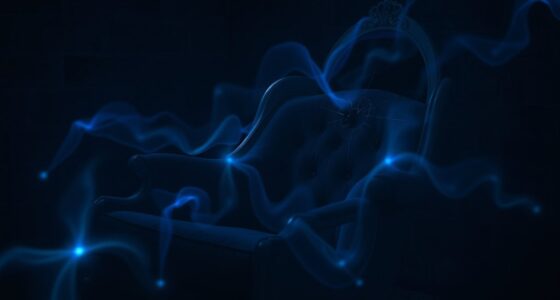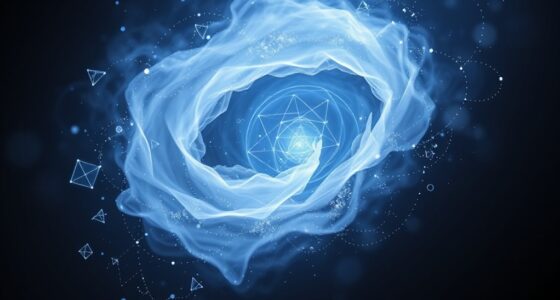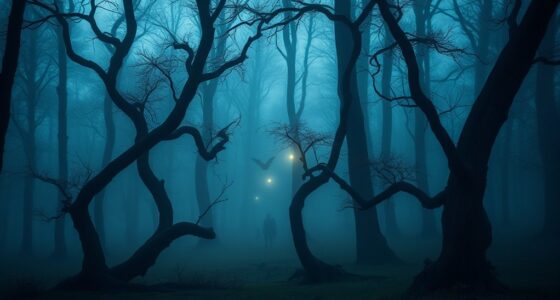Photos can create ghostly illusions through natural causes like lens flare, motion blur, reflections, shadows, or sensor noise, especially in low light. Your perceptions are influenced by cognitive biases such as pareidolia and confirmation bias, making you see spirits where there are none. By understanding how camera artifacts and lighting tricks work, you can better distinguish real phenomena from tricks of the eye. Keep exploring to uncover more about what makes images appear haunted.
Key Takeaways
- Many ghost images result from camera artifacts like lens flare, motion blur, or sensor noise, which are natural, not supernatural.
- Cognitive biases such as pareidolia and confirmation bias cause viewers to see ghostly forms in ambiguous images.
- Proper analysis of lighting, shadows, and scene context helps differentiate genuine photos from manipulated or accidental illusions.
- Digital tools can detect signs of editing, inconsistencies, or anomalies that reveal fakery or photo manipulation.
- Recognizing common photographic artifacts and understanding light-shadow interactions are essential for scientifically debunking haunted images.
The Physics Behind Ghostly Appearances in Photos
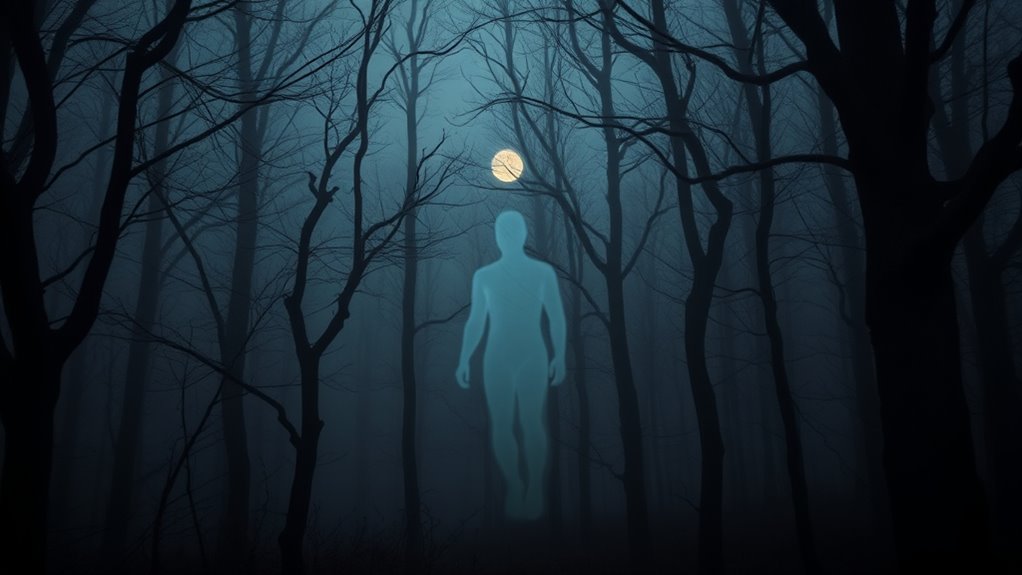
Many ghostly images in photos aren’t supernatural but are instead caused by the physics of light and camera technology. Camera sensor noise often appears as random specks or grainy patches, especially in low-light conditions, creating ghost-like shapes that seem to float in the image. Similarly, lens flare artifacts occur when bright light sources, like the sun or streetlights, reflect within the lens elements, producing streaks or halos that can resemble apparitions. These optical effects happen naturally due to the way cameras capture light, not supernatural activity. Additionally, automation in camera systems helps reduce these artifacts by compensating for lighting conditions, but understanding how sensor noise and flare artifacts form helps you recognize that many eerie images are simply the result of light interactions within your camera system, not paranormal phenomena. Recognizing these light interactions can help differentiate between genuine paranormal sightings and camera artifacts. Moreover, awareness of sensor limitations enables photographers to better interpret their images and avoid misjudging ordinary camera effects as supernatural phenomena. Being familiar with image processing techniques can further assist in analyzing and clarifying ambiguous images. Understanding these optical phenomena also aids in developing critical thinking when evaluating mysterious images.
Common Camera Artifacts That Mimic Paranormal Activity
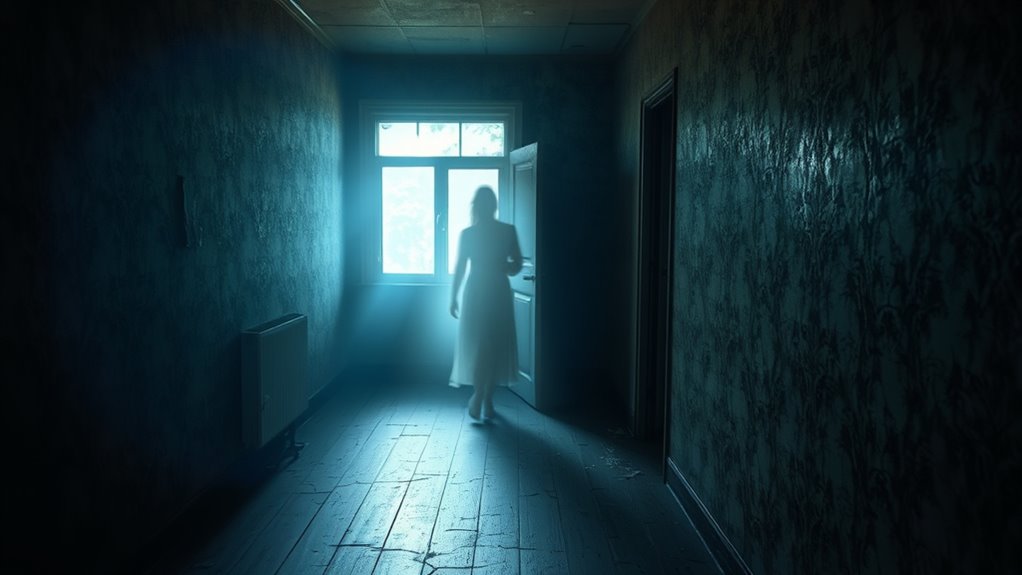
Camera artifacts often create images that look eerily like paranormal activity, leading many to mistake technical glitches for ghosts. These artifacts can result from issues with the camera lens, image compression, or sensor anomalies. For example, reflections or lens flare caused by the camera lens can produce ghostly shapes or orbs that seem supernatural. Image compression can also create compression artifacts—blocky or blurry areas—that resemble strange figures. Additionally, digital noise or sensor dust may appear as mysterious spots or figures in photos. Understanding these common camera artifacts helps you distinguish between real paranormal images and technical glitches. Being aware of these factors prevents misinterpretation of everyday camera issues as supernatural phenomena. Recognizing sensor anomalies and other technical issues can help you see through the illusions caused by camera technology. Furthermore, software processing errors may sometimes introduce or exaggerate these artifacts, complicating the analysis. Educating oneself about digital image quality and common camera malfunctions can further aid in accurate interpretation of photos. Awareness of camera lens effects is also essential to avoid mistaking optical phenomena for paranormal activity. Additionally, staying informed about image enhancement techniques can help identify artificially altered images that mimic paranormal phenomena.
The Role of Lighting and Shadows in Creating Spooky Images
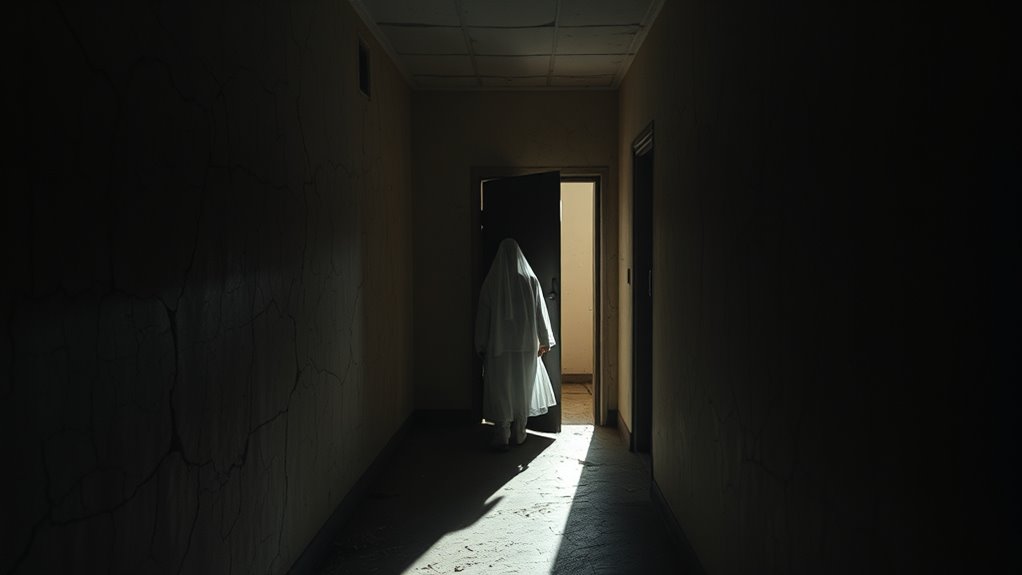
Lighting and shadows play a pivotal role in creating spooky images because they can dramatically alter the perception of a scene. Through light manipulation, photographers or viewers can emphasize certain elements or obscure others, leading to eerie interpretations. Shadow illusions are especially powerful; a simple shadow cast at the right angle can resemble a ghostly figure or paranormal entity. Poor lighting conditions or unexpected light sources can create ambiguous shapes that seem to float or move unnaturally. By understanding how shadows and lighting interact, you can recognize when a spooky image is the result of deliberate or accidental shadow illusions rather than supernatural activity. Mastering this knowledge helps you see through deceptive lighting tricks and debunk ghostly appearances with confidence.
Psychological Factors Influencing Perceptions of Haunted Photos
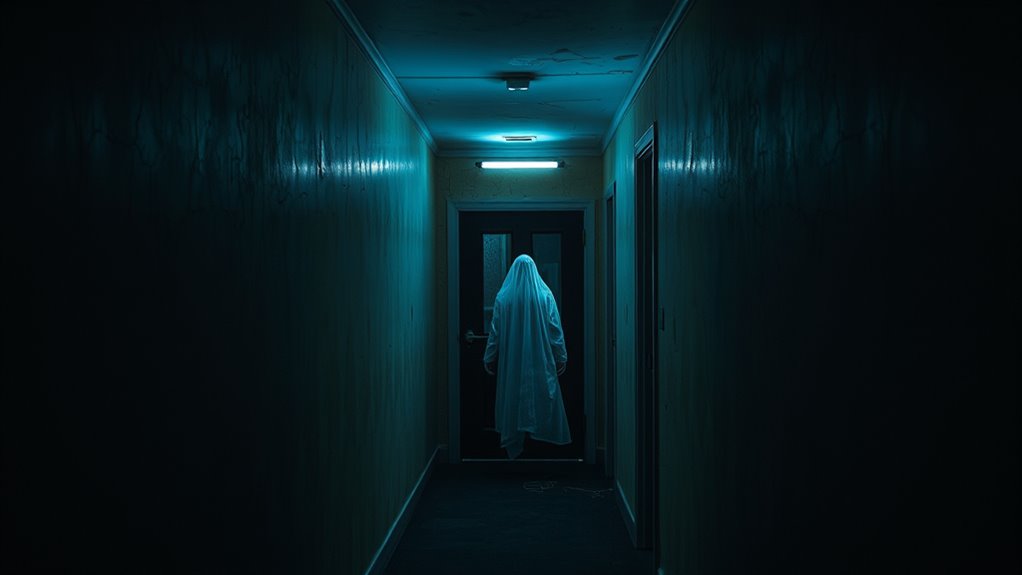
Your mind can easily be influenced by biases that make you see what you expect to see in haunted photos. When you’re convinced a picture is haunted, your perception shifts to confirm that belief, even if there’s no real evidence. Emotions also play a big role, as fear and curiosity can distort your interpretation of ambiguous images. Additionally, visual perception can be deceived by the way our brains interpret shadows, lighting, and patterns, leading us to see things that aren’t really there. Understanding how cognitive biases shape our perceptions can help explain why people often perceive paranormal activity where none exists. Recognizing the influence of perceptual errors can further illuminate how our expectations and prior beliefs distort our interpretation of ambiguous visuals. For example, the way interpretation of illusions works demonstrates how easily our visual system can be fooled under certain conditions. Moreover, our brain’s pattern recognition tendencies can cause us to connect unrelated elements into a coherent but false narrative, especially in unclear images.
Cognitive Bias Effects
Cognitive biases play a significant role in how people interpret ambiguous or strange images as evidence of paranormal activity. You might see a face or figure where none exists due to these mental shortcuts. Confirmation bias leads you to focus on details that support your beliefs in ghosts, ignoring evidence to the contrary. Pareidolia causes your brain to find familiar patterns, like faces, in random shapes or shadows. These biases skew your perception, making you more likely to interpret a blurry photo as haunted. To recognize this, consider:
- Your tendency to seek confirming evidence
- How pareidolia creates illusions of faces
- The influence of existing beliefs on interpretation
- Overlooking natural explanations
- The role of cognitive shortcuts in perception
Understanding these biases helps you critically evaluate ghost images. Regular exposure to Glycolic Acid in skincare routines has been shown to improve skin clarity and reduce the appearance of imperfections, which can also influence how we interpret visual stimuli.
Expectation and Perception
Expectations shape how you perceive haunted photos, often influencing what you see more than the actual image does. When viewing, your mind tends to fill in gaps based on prior beliefs or cultural symbolism, leading to artistic interpretation that confirms your expectations. If you’re familiar with ghost stories or haunted legends, you might interpret ambiguous shapes as supernatural entities. Cultural symbolism also plays a role, as certain symbols or figures evoke specific associations that prime you to see paranormal phenomena. This psychological bias can cause you to perceive images in a way that aligns with your beliefs, even if the photo simply contains random patterns. Recognizing how expectation influences perception helps you critically evaluate haunted photos, separating genuine anomalies from those shaped by your mind’s predispositions.
Emotional Influence Factors
Emotions play a powerful role in shaping how you interpret haunted photos, often amplifying or distorting what you see. Your emotional bias influences visual perception, making you more likely to interpret ambiguous images as paranormal. When you’re anxious or excited, your mind fills in gaps with spooky details, heightening the illusion of a ghost. Conversely, feeling calm can lead to more skeptical interpretations.
Consider these factors:
- Personal fears heighten sensitivity to spooky images
- Past experiences influence your perception
- Cultural beliefs shape what you see as supernatural
- Anxiety or excitement can distort visual perception
- Confirmation bias reinforces your belief in ghosts
Understanding emotional influence factors helps you recognize how feelings skew your perception of haunted photos, making you aware of the psychological tricks at play.
Techniques and Tools Used to Debunk Supernatural Photographs
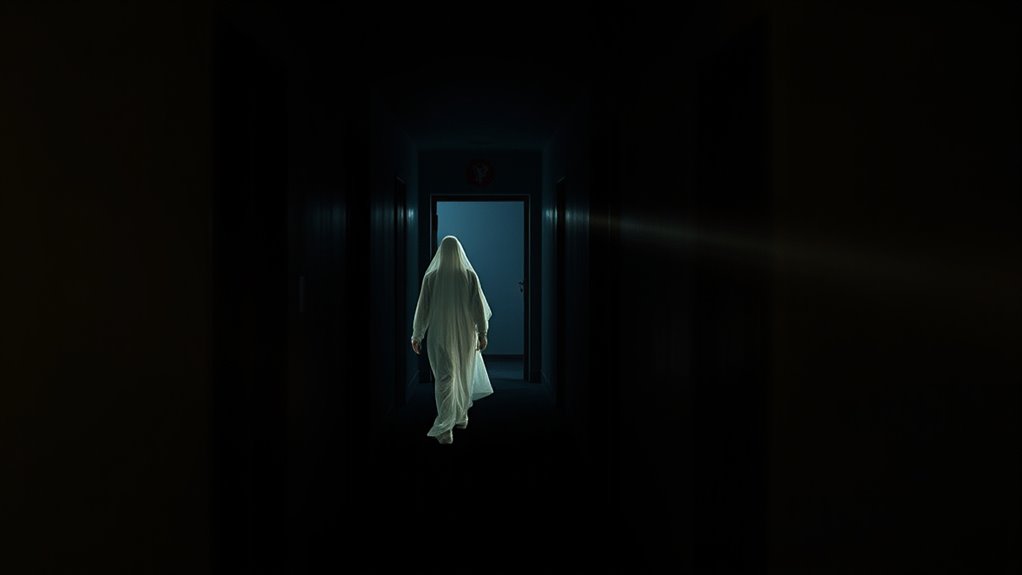
When examining supernatural photographs, skeptics rely on a range of techniques and tools to identify hoaxes and natural explanations. Digital manipulation is a primary method; skeptics analyze images with software to detect inconsistencies, edits, or enhancements that reveal fakery. They also look for signs of digital tampering, such as irregular shadows or mismatched pixels. Additionally, understanding cultural symbolism helps debunk images by recognizing common motifs or symbols that are often added to create supernatural effects. By cross-referencing photographs with known cultural references, skeptics can determine whether the image was intentionally altered to evoke a ghostly presence. These techniques allow you to critically evaluate supernatural photos, distinguishing genuine phenomena from deliberate fabrications or natural causes.
Real-Life Examples: Separating Fact From Fiction in Haunted Images

When you analyze haunted photos, it’s important to recognize common artifacts like lens flares or reflections that can look eerie. By understanding these typical anomalies, you can better distinguish genuine paranormal images from everyday camera glitches. Let’s explore some real-life examples to see how these factors come into play.
Common Photo Artifacts
Many so-called haunted images are actually the result of common photo artifacts that can easily be mistaken for paranormal phenomena. These include optical flaws like lenses distortion, which can create ghostly shapes or blurs that seem eerie. Digital editing also plays a role, where photos are manipulated to add or remove elements, leading to false impressions. Motion blur from camera movement can produce strange apparitions, while reflections and light flares create mysterious shapes. Additionally, shadows can appear uncanny, especially in low-light conditions. Recognizing these artifacts helps you distinguish real paranormal images from technical quirks. Being aware of these common issues allows you to critically analyze haunted photos and avoid jumping to supernatural conclusions.
- Lenses distortion creating ghostly shapes
- Digital editing adding false apparitions
- Motion blur producing strange figures
- Reflections and light flares mimicking spirits
- Shadows in low-light settings creating illusions
Analyzing Haunted Photos
Have you ever come across a haunted photo that seems too convincing to be real? When analyzing such images, look for signs of digital manipulation or inconsistencies. Cultural interpretations often influence how we perceive these photos, but scientific scrutiny is key. Consider this table:
| Clues to Authenticity | Red Flags of Deception |
|---|---|
| Natural lighting | Unnatural glow |
| Consistent shadows | Disjointed shadows |
| Genuine reflections | Odd reflections |
| Clear focus | Blurred areas |
| Context matches scene | Incongruent elements |
Frequently Asked Questions
Can Editing Software Be Used to Convincingly Fake Ghost Images?
You can definitely use editing software to convincingly fake ghost images through digital manipulation. By carefully altering or adding elements, you can create photos that seem authentic. However, verifying authenticity becomes essential; tools for authenticity verification can help detect such manipulations. While software makes faking easier, understanding these techniques allows you to better scrutinize images and determine if they’re genuine or artificially created.
Are There Specific Cameras More Prone to Capturing False Paranormal Images?
Imagine capturing a fleeting specter in the fog—certain cameras are more prone to false paranormal images. Cameras with smaller sensors often generate more sensor noise, creating ghostly apparitions. Similarly, lenses prone to flare can produce strange, unexplained shapes. These artifacts can resemble paranormal images, making you question what you see. So, understanding your camera’s quirks helps you distinguish real phenomena from digital illusions.
How Do Cultural Beliefs Influence Interpretations of Ghostly Photographs?
You might notice that your cultural beliefs and symbolism shape how you interpret ghostly photos. If your belief system includes spirits or supernatural entities, you’re more likely to see ghostly images as real. Conversely, skepticism can lead you to dismiss these photos as tricks or coincidences. Your background influences your perception, making cultural symbolism a powerful lens through which you interpret paranormal images, often coloring your belief in their authenticity.
Can Unusual Weather Conditions Create Illusions Similar to Paranormal Phenomena?
You might think the sky’s the limit, but unusual weather conditions can really play tricks on your eyes. Optical illusions caused by atmospheric distortions, like heat waves or fog, can create shapes and figures that look ghostly or paranormal. These natural phenomena deceive your perception, making you see things that aren’t really there. So, before jumping to conclusions, consider how atmospheric distortions can produce illusions similar to paranormal phenomena.
What Psychological Biases Affect How Viewers Perceive Ambiguous Images?
You’re influenced by cognitive biases and perception heuristics when viewing ambiguous images. These mental shortcuts help you interpret unclear visuals quickly but can lead to misperceptions, especially if you expect a certain outcome. For example, confirmation bias makes you see what you want to see, while the availability heuristic causes you to interpret images based on recent experiences. Recognizing these biases helps you critically evaluate ambiguous images rather than jumping to paranormal conclusions.
Conclusion
As you examine haunted photos, remember that science often reveals the truth behind the illusions. What seems supernatural may just be clever tricks of light, shadows, or camera quirks. But within those mysterious images lies a subtle tension—an invitation to question what you see. Will you accept the explanation, or will the allure of the unknown tempt you to believe? The answer may be waiting just beyond the frame, in the shadows of your mind.



